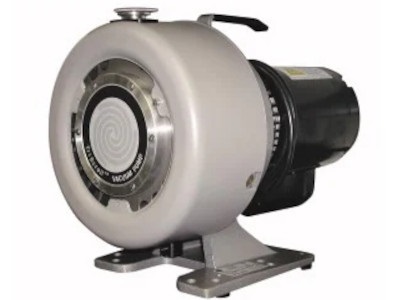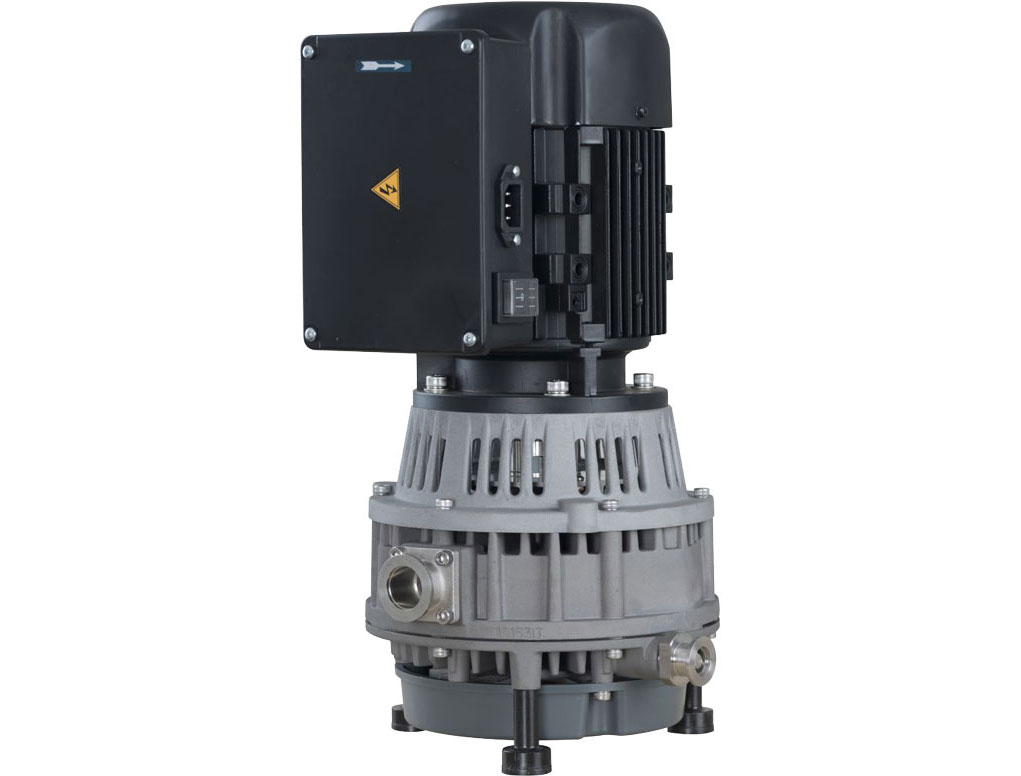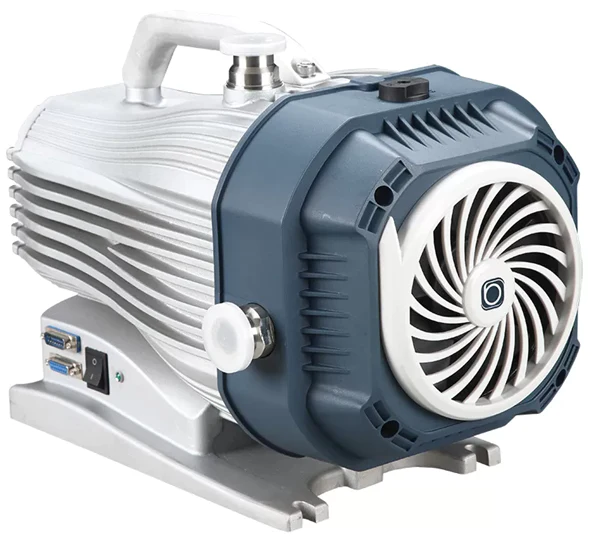Product Description
Oil free mechanical scroll vacuum pump
Motor Power: 750 W
Pumping speed: 12 m³/h
Ultimate pressure: 0.01 mbar
The scroll vacuum pump is a new generation of oil-free mechanical pump, which has the advantages of simple structure, good sealing performance and high ultimate vacuum. As a high-tech product, the scroll dry vacuum pump has a very high technical content in design and production. It has obvious features such as low operating cost, long working life, high reliability and low noise in application. It has unparalleled advantages in oil cleaning applications and are therefore highly regarded by the market. The RGP series scroll dry pump is a vortex dry pump with advantages of excellent performance and competitive price , which is developed by CHINAMFG Vacuum for the downstream application of domestic and foreign markets.
| Technique data | Unit | SCR300 |
| Rated speed | rpm | 1800 |
| Theoretical pumping speed | m3/h | 12 |
| Ultimate vacuum degree | mbar | 0.01 |
| Motor power | W | 750 |
| Input voltage | V | Single phase 100-240 |
| Dimensions(L*W*H) | mm | 367*270*250 |
| Noise | dB(A) | 54 |
| Inlet port | KF25 | |
| Outlet port | KF25 | |
| Water vapor treatment capacity | gh-1 | 100 |
| Leak rate | Mbar.l/s | <1*10-6 |
| Weight | kg | 25 |
| Cooling type | air cooling | |
| Operating ambient temperature | ºC | 10-40 |
Application
General cleaning vacuum acquisition applications, molecular pump foreline pumps, laboratory vacuum systems, analytical instruments, vacuum leak detection / helium mass spectrometry leak detection, beam line / high energy physics, scientific research, clinical medical equipment, distillation / extraction / filtration, laser, Gas recovery and recycling, semiconductor (LED/LCD crystal growth furnace), photovoltaic (single crystal furnace/polycrystalline furnace), coating (PVD/CVD), industrial/battery production, glove box/exhaust table, electron beam welding/ Laser welding, space environment simulation.
| Oil or Not: | Oil Free |
|---|---|
| Structure: | Scroll Vacuum Pump |
| Exhauster Method: | Entrapment Vacuum Pump |
| Vacuum Degree: | Vacuum |
| Work Function: | Mainsuction Pump |
| Working Conditions: | Dry |
| Customization: |
Available
|
|
|---|

Can scroll vacuum pumps be used in semiconductor manufacturing and research?
Yes, scroll vacuum pumps can be used in semiconductor manufacturing and research. Here's a detailed explanation:
Scroll vacuum pumps are widely utilized in various applications within the semiconductor industry, including both manufacturing processes and research activities. These pumps offer several advantages that make them suitable for semiconductor-related applications:
1. Clean and Oil-Free Operation:
Scroll vacuum pumps are available in oil-free versions, making them well-suited for semiconductor manufacturing and research environments that require a high level of cleanliness. Oil-free operation eliminates the risk of oil contamination, which is crucial in preventing particles or residues that could adversely affect semiconductor device fabrication or research experiments.
2. High Reliability and Uptime:
Scroll vacuum pumps are known for their reliable performance and minimal maintenance requirements. This is particularly important in semiconductor manufacturing, where continuous operation and high uptime are critical for maximizing productivity. The robust design and minimal wear parts of scroll pumps contribute to their long-term reliability and reduced downtime.
3. Low Vibration and Noise:
Scroll vacuum pumps operate with low vibration levels, which is advantageous in semiconductor manufacturing and research settings. Excessive vibrations can disrupt delicate semiconductor fabrication processes or interfere with sensitive research measurements. Additionally, scroll pumps are designed to operate quietly, contributing to a more comfortable and productive working environment.
4. Good Pumping Speed and Ultimate Vacuum:
Scroll vacuum pumps offer efficient pumping speeds, enabling rapid evacuation of process chambers or research apparatus. They can achieve high vacuum levels, which are necessary for various semiconductor manufacturing and research applications, such as thin film deposition, plasma etching, or surface analysis techniques.
5. Compact and Space-Saving:
Scroll vacuum pumps have a compact design and a smaller footprint compared to some other types of vacuum pumps. This is beneficial in semiconductor manufacturing facilities or research laboratories where space is often limited. The compact size of scroll pumps allows for easier integration into existing systems or setups.
6. Compatibility with Semiconductor Processes:
Scroll vacuum pumps are compatible with a wide range of semiconductor manufacturing processes, including vacuum deposition, etching, ion implantation, and thermal processing. They can handle various gases, vapors, and byproducts encountered in these processes, contributing to their versatility.
It is important to consult the manufacturer's specifications and guidelines to ensure that the specific scroll vacuum pump model is suitable for the semiconductor manufacturing or research requirements. Manufacturers can provide information on the pump's performance characteristics, materials compatibility, and any additional features or considerations specific to semiconductor applications.
By utilizing scroll vacuum pumps in semiconductor manufacturing and research, companies and researchers can benefit from their clean operation, reliability, high vacuum performance, and compatibility with a wide range of processes. These pumps play a vital role in enabling the production of high-quality semiconductor devices and supporting cutting-edge research in the semiconductor field.

Do scroll vacuum pumps require water cooling or air cooling systems?
Scroll vacuum pumps can be designed to utilize either water cooling or air cooling systems. Here's a detailed explanation:
Water Cooling Systems:
Some scroll vacuum pumps are equipped with water cooling systems to dissipate the heat generated during operation. Water cooling offers efficient heat removal and helps maintain the pump at optimal operating temperatures. These pumps typically have connections for water inlet and outlet, allowing the circulation of cooling water through the pump's heat exchanger or jacket.
Water cooling systems are commonly used in applications where the pump operates at higher duty cycles or when the ambient temperature is relatively high. They are particularly advantageous when there is a need for continuous or extended operation at elevated vacuum levels, as water cooling provides effective heat dissipation and prevents overheating of the pump.
Air Cooling Systems:
Alternatively, some scroll vacuum pumps utilize air cooling systems. These pumps rely on the circulation of ambient air to dissipate the heat generated during operation. Air cooling systems typically incorporate cooling fins or fans to enhance heat transfer and maintain the pump within the acceptable temperature range.
Air cooling systems are commonly used in applications where water availability or infrastructure is limited. They are suitable for situations where the pump duty cycle is lower, and the operating conditions do not result in excessive heat generation.
Selection Considerations:
When choosing between water cooling and air cooling systems for a scroll vacuum pump, several factors should be considered:
- Duty Cycle: The duty cycle of the pump, which refers to the ratio of operating time to resting time, can influence the heat generation. Higher duty cycles may require water cooling for efficient heat dissipation.
- Operating Environment: The ambient temperature and availability of water resources in the operating environment should be assessed. Water cooling may be preferred in high-temperature environments or when water is readily available.
- Application Requirements: The specific requirements of the application, including desired vacuum level, pumping speed, and operating conditions, should be considered to determine the appropriate cooling system.
- Maintenance and Infrastructure: The availability of maintenance resources, infrastructure for water circulation, and any specific facility requirements should be evaluated when selecting the cooling system.
It's essential to consult the manufacturer's specifications and guidelines to determine the recommended cooling system for a particular scroll vacuum pump model. This ensures optimal performance, longevity, and reliability of the pump in the intended application.

How does the scroll design contribute to the reliability of these pumps?
The scroll design of vacuum pumps plays a significant role in enhancing their reliability. Here's an explanation of how the scroll design contributes to the reliability of these pumps:
1. Sealed System:
The scroll design features two interleaved spiral scrolls, one fixed and one orbiting. The interaction between these scrolls creates a series of crescent-shaped chambers. As the orbiting scroll moves, these chambers decrease in size, compressing and expelling gases. The tightly sealed system of the scroll design ensures minimal leakage, preventing the entry of contaminants and maintaining a consistent vacuum level. This sealed system enhances the reliability of scroll vacuum pumps by minimizing the risk of performance degradation and ensuring continuous and efficient operation.
2. Oil-Free Operation:
One of the key advantages of scroll vacuum pumps is their oil-free operation. Unlike other types of pumps that rely on oil lubrication, scroll pumps utilize a dry mechanism. The scroll design eliminates the need for oil lubrication by using non-contacting, self-lubricating materials such as PTFE (polytetrafluoroethylene) or carbon. This eliminates the risk of oil contamination in the pumped gases or the vacuum chamber. The absence of oil also reduces maintenance requirements and enhances the reliability of the pumps by eliminating the potential for oil-related issues, such as oil degradation, leaks, or mechanical failures.
3. Minimal Moving Parts:
The scroll design features a relatively simple construction with minimal moving parts. Compared to other types of pumps, scroll vacuum pumps have fewer components that can wear out or malfunction. This reduces the likelihood of mechanical failures and improves the overall reliability of the pumps. The simplicity of the scroll design also contributes to ease of maintenance and servicing, further enhancing their reliability and uptime.
4. Low Vibration and Noise Levels:
The scroll design of vacuum pumps results in smooth and quiet operation. The absence of reciprocating pistons or vanes, which are common in other pump designs, reduces vibration levels. This lower vibration minimizes the stress on pump components, reducing wear and tear and improving the overall reliability. Additionally, the low noise levels of scroll pumps make them suitable for applications that require a quiet working environment, such as laboratories or medical facilities.
5. Contamination Resistance:
The scroll design of vacuum pumps offers inherent contamination resistance. The absence of oil lubrication eliminates the risk of oil carryover or oil-related contamination. Additionally, the sealed system and non-contacting scroll surfaces reduce the chances of particulate contamination or wear debris generation. This contamination resistance contributes to the long-term reliability of the pumps by minimizing the potential for performance degradation or damage to sensitive components.
In summary, the scroll design of vacuum pumps enhances their reliability through a sealed system, oil-free operation, minimal moving parts, low vibration and noise levels, and contamination resistance. These factors make scroll vacuum pumps a reliable choice for various industrial applications.


editor by CX 2023-11-15
